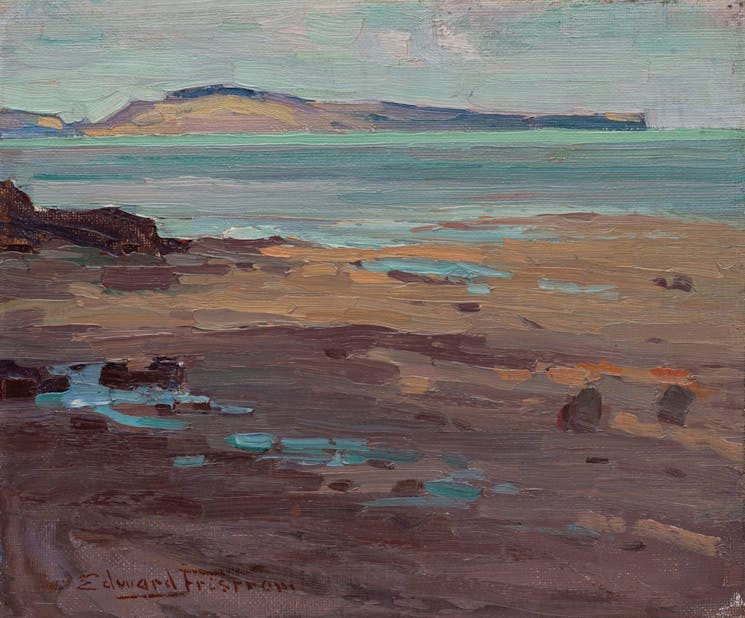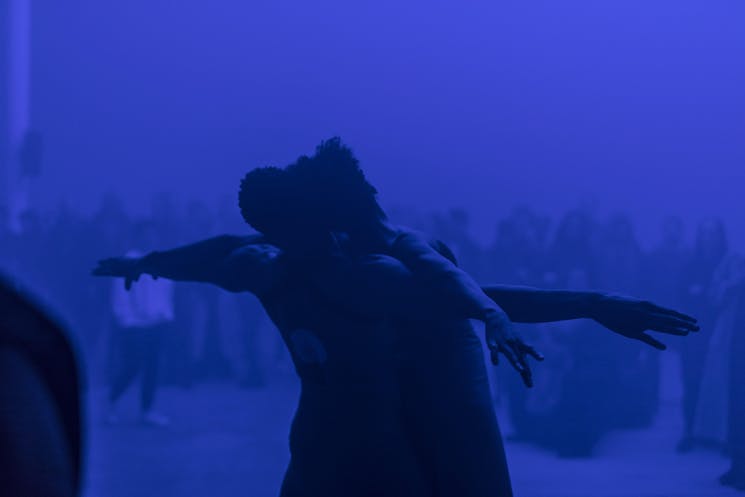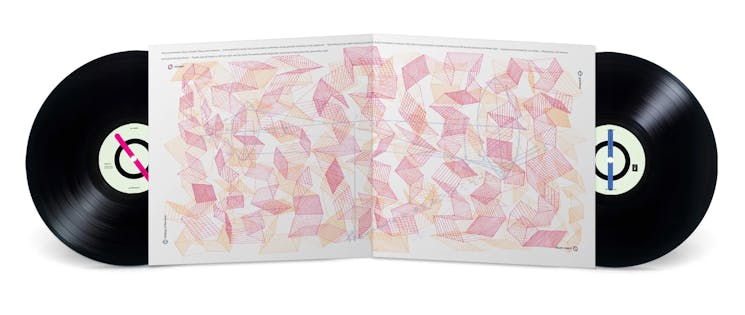“It’s all a mystery, you’re in it, you have to discover it, give it reason…–Alan Pearson, New Zealand Cultural Icons documentary 28 & 29, 2010
Mercurial in nature, Alan Pearson had an ability to switch from expressionist representation to abstraction while revealing the underlying spirit and psyche in a person or place. When discovering a new location and needing to understand and establish the resident form, colour and light, he would use the old academic methods; landscape, still life, life drawing and portraiture. That method formed the basis of any artistic narrative he subsequently chose to articulate. The diversity in imagery in this exhibition is offset by unifying colours and his expression of what it means to give life meaning.
A self-portrait painted in Auckland, 1967 (the earliest work in this show) is dominated by ultramarine blue, sap green, and cadmium yellow. The Fauvist use of colour illustrates the artist’s introspective mood, and the elemental environment of Auckland. Elemental forces also honed the shape of the landscape in the Olive trees, Tuscany where blackened, gnarled trunks bend against the prevailing wind. The use of a nail to etch the painted surface conveys age and survival. In contrast the lush sensuous pigments in Symphonic study, 10 Mile (north of Greymouth) is painterly, with accents of golden brushstrokes creating a sense of time, indicative of both antiquity and the real gold hidden beneath the fertile forest canopy.
A life-long love of music and dance enhanced Alan’s understanding of flowing forms whether in the figurative drawings Jennifer and When the spirit calls or in his abstract Bush symphony series one of which is Harmony in lemon yellow. Rhythmic shapes, shadows of tree trunks lit by the morning sun, emerge from the depths of the forest. Using yellow and black to ‘harmonise’ is risky because symbolically placed together they represent danger. Alan loved Tchaikovsky’s first piano concerto and that composition reverberates with the emotional transition from despair to enlightenment, the same emotional dichotomy in yellow and black ‘harmonise’ within the painting.
Alan saw music in the landscape at Huia, at the head of the Manukau harbor, which was the site for the double portrait, Huia Couple, Leo and Linda in the Christchurch Art Gallery collection. Spending time painting in situ Alan observed and came to love the clouds scudding through the sky and wind billowing through the trees. In Huia Variations, Ti-tree chorus light in the vortex is filled with manuka (ti-trees) flowing left to right. In both Ti-tree chorus and …Huia, Pink ladies Alan sought a smooth surface that would make the paint flow to create chorus-lines. Wah Lee’s shop in Hobson Street provided the calligraphy brushes and the red-lipped ‘pink ladies’ were locally inspired by a bakery in Herne Bay that Alan passed on his morning walk. Wherever the eye wanders in this painting there is animated colour and music: dissonance and harmony.
Wit and mischief (personal traits) enliven the abstract Huia works and the drawings (Hello, with its cheeky sideways glance and the flat perspective in I love you) are the cartoon outcome of analyzing hundreds of psyches throughout his career in portraiture.
The ease with which he could paint a figure or a head is visible also in the three Madonna paintings in this show. They are also evidence of his respect for art’s historical tradition but these are Pacific Madonnas. Still-life and Madonna continues the history of reverence for the mother figure since time immemorial, however, contrary to the western art tradition of placing the Madonna in the forefront, this figure is inscribed by black lines and placed in deep shade at the back of the picture plane becoming part of an overall contemplative composition.
In Huia maiden, the same dark lines delineate limbs, but cross-hatched marks present the body in flesh-toned chiaroscuro and exclaim the Madonna as part of the fertile landscape (complete with a biblical snake character whispering to her). Pacific Madonna is alive with the contrast of yellow and black and hot red decoration that seem to fuel the Madonna’s penetrating gaze. This depiction, in contemporary form and colour, reminds us of the ‘Black Madonna’ tradition, that she symbolically guides us through darkness and represents the inner process of transformation. It is a work that weaves mystery and reason and is eternally relevant to us at any time.
–Alison Pearson, February, 2021
Opening Hours
- Monday - Friday, 10am - 6pm
- Saturday - Sunday, 10am - 4pm
Address
- Osborne Lane, 2 Kent Street
- Newmarket
- Tāmaki Makaurau, Auckland, 1023
“It’s all a mystery, you’re in it, you have to discover it, give it reason…–Alan Pearson, New Zealand Cultural Icons documentary 28 & 29, 2010
Mercurial in nature, Alan Pearson had an ability to switch from expressionist representation to abstraction while revealing the underlying spirit and psyche in a person or place. When discovering a new location and needing to understand and establish the resident form, colour and light, he would use the old academic methods; landscape, still life, life drawing and portraiture. That method formed the basis of any artistic narrative he subsequently chose to articulate. The diversity in imagery in this exhibition is offset by unifying colours and his expression of what it means to give life meaning.
A self-portrait painted in Auckland, 1967 (the earliest work in this show) is dominated by ultramarine blue, sap green, and cadmium yellow. The Fauvist use of colour illustrates the artist’s introspective mood, and the elemental environment of Auckland. Elemental forces also honed the shape of the landscape in the Olive trees, Tuscany where blackened, gnarled trunks bend against the prevailing wind. The use of a nail to etch the painted surface conveys age and survival. In contrast the lush sensuous pigments in Symphonic study, 10 Mile (north of Greymouth) is painterly, with accents of golden brushstrokes creating a sense of time, indicative of both antiquity and the real gold hidden beneath the fertile forest canopy.
A life-long love of music and dance enhanced Alan’s understanding of flowing forms whether in the figurative drawings Jennifer and When the spirit calls or in his abstract Bush symphony series one of which is Harmony in lemon yellow. Rhythmic shapes, shadows of tree trunks lit by the morning sun, emerge from the depths of the forest. Using yellow and black to ‘harmonise’ is risky because symbolically placed together they represent danger. Alan loved Tchaikovsky’s first piano concerto and that composition reverberates with the emotional transition from despair to enlightenment, the same emotional dichotomy in yellow and black ‘harmonise’ within the painting.
Alan saw music in the landscape at Huia, at the head of the Manukau harbor, which was the site for the double portrait, Huia Couple, Leo and Linda in the Christchurch Art Gallery collection. Spending time painting in situ Alan observed and came to love the clouds scudding through the sky and wind billowing through the trees. In Huia Variations, Ti-tree chorus light in the vortex is filled with manuka (ti-trees) flowing left to right. In both Ti-tree chorus and …Huia, Pink ladies Alan sought a smooth surface that would make the paint flow to create chorus-lines. Wah Lee’s shop in Hobson Street provided the calligraphy brushes and the red-lipped ‘pink ladies’ were locally inspired by a bakery in Herne Bay that Alan passed on his morning walk. Wherever the eye wanders in this painting there is animated colour and music: dissonance and harmony.
Wit and mischief (personal traits) enliven the abstract Huia works and the drawings (Hello, with its cheeky sideways glance and the flat perspective in I love you) are the cartoon outcome of analyzing hundreds of psyches throughout his career in portraiture.
The ease with which he could paint a figure or a head is visible also in the three Madonna paintings in this show. They are also evidence of his respect for art’s historical tradition but these are Pacific Madonnas. Still-life and Madonna continues the history of reverence for the mother figure since time immemorial, however, contrary to the western art tradition of placing the Madonna in the forefront, this figure is inscribed by black lines and placed in deep shade at the back of the picture plane becoming part of an overall contemplative composition.
In Huia maiden, the same dark lines delineate limbs, but cross-hatched marks present the body in flesh-toned chiaroscuro and exclaim the Madonna as part of the fertile landscape (complete with a biblical snake character whispering to her). Pacific Madonna is alive with the contrast of yellow and black and hot red decoration that seem to fuel the Madonna’s penetrating gaze. This depiction, in contemporary form and colour, reminds us of the ‘Black Madonna’ tradition, that she symbolically guides us through darkness and represents the inner process of transformation. It is a work that weaves mystery and reason and is eternally relevant to us at any time.
–Alison Pearson, February, 2021


